It’s winter in Maryland. In fact, it’s so much winter I shoveled 10 inches of snow off my driveway this morning. Fortunately, I had company. It wasn’t the kind of company that picks up a shovel and helps out, but still, the American robins darting back and forth over my head were still welcome (if surprising and surprisingly quiet) snow day companions.
Become a Member
Make a lasting impact for nature when you join The Nature Conservancy
“You know,” I said to them as I leaned on my shovel to watch about 25 birds flock together in my neighbor’s oak. “I think y’all are a little early—aren’t you supposed to be the first harbingers of spring?”
We’re not even a month past the first day of winter in the northern hemisphere. Spring is definitely not here. So why are the robins? Shouldn’t they be sunning themselves in warmer climes?
The short answer: as long as there’s food, American robins—true to their name Turdus migratorius (“the wandering thrush”)—kind of spend their winters coming and going as they please.
Robin Migration (AKA Robin Wandering)
Robins do migrate—but they don’t necessarily follow a more or less straight line from north to south in the fall, then repeat the journey south to north in the spring. In the fall and winter, when the ground freezes, robins lose access to their meal of choice: worms, insects (adult and larval) and (occasionally) snails. That’s when they turn to their winter diet staple: mostly fruit, mostly berries.
The folks at Journey North, a project tracking robin movements run by the University of Wisconsin-Madison, put it this way, “Some robins retreat all the way to southern Texas and Florida (in fact, some of the largest winter flocks documented by the Christmas Bird Count gather in sunny St. Petersburg, Florida), but others winter as far north as they can find berries. So they have an enormous winter range. Robins do migrate, but it has more to do with food sources than with being faithful to the same places year over year.”
In that way American robins are somewhat akin to teenage boys—they tend to go where the best (or most abundant or most easily accessible) food is, stay until it’s depleted, and then move on.
So as long as there are enough berries and other fruits to sustain them, you may see robins off and on throughout the winter across much of North America.
Forget the birdseed though. Robins’ digestive systems, unlike sparrows or other so-called feeder birds, aren’t built for dealing with seed, and their beaks aren’t built for cracking things open. Robin beaks are built for snapping up worms, catching insects, and plucking berries and other fruits. In the winter, a flock of robins can strip a holly bush with impressive speed and efficiency, and very little—if any—violent robin-on-robin aggression.
Food is also one of the reasons that robins, notoriously territorial and aggressive in breeding season, tend to gather and travel in flocks in the fall and winter. Numbers are good for defense, and also for spotting food—if one robin happens on a holly tree full of bright, ripe berries, the whole flock can partake. And then move on.
The tendency of robins to flock in winter may also be one of the reasons people seem to notice them—birds in large numbers tend to stand out when they’re gathered in leafless trees. (That and the beautiful red breast that is sometimes the only splash of color in a winter landscape that looks practically lunar in relentless shades of February white and gray.)
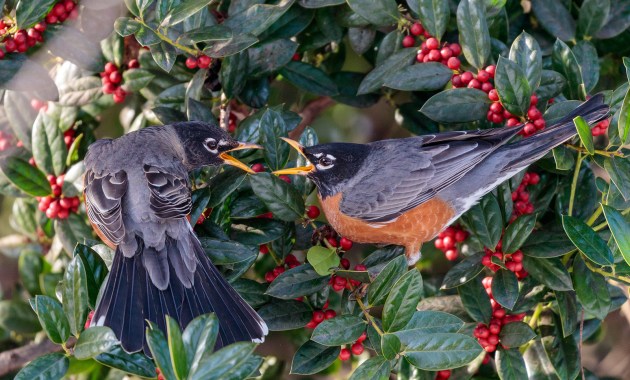
How do Robins Survive the Cold?
Robins are outfitted to survive huge temperature variances. In fact, hot weather seems to stress them more than cold.
If an American robin is healthy, has enough to eat, and is able to main its feathers, the temperature next to its body stays around 104 F—regardless of how cold it is in the world outside. It really is all about those feathers. (And the legs and feet.)
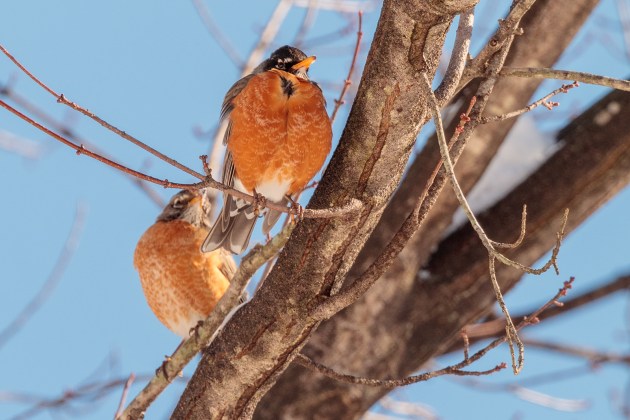
Robins, like most birds, have layers of feathers that perform different functions. When temperatures drop, robins puff the fine, downy feathers closest to their bodies to keep heat in, cold out. The outer feathers act like a kind of overcoat, shedding water and moisture and helping to regulate the bird’s temperature. (It’s an adaptation not limited to robins. Most birds with down feathers fluff them to regulate body heat).
The anatomy of a robin’s (and other bird species) also contributes to their cold adaptations. The bird experts over at the Cornell Lab explain it very well. The simplified version is that “most birds don’t succumb to frostbite because there is so little fluid in the cells of their feet, and their feet are mostly tendons and bones with little muscle or nerve tissue.”
So while blood does flow to their legs and feet, most birds (including robins) benefit from a very fast circulatory system and a “countercurrent heat exchange system.” Because bird legs are thin, the vessels that move blood from the heart to the feet and back again are very close together. That proximity means, per Cornell, “blood flowing back to the body is warmed by blood flowing to the feet. The newly cooled blood in the feet lowers heat loss from the feet, and the warmed blood flowing back into the body prevents the bird from becoming chilled.”
Robins: The Tell-Tale Birds of Spring
If robins are around in winter, why have they always been associated with the beginning of spring in the U.S.? Most likely it has to do with ground thaw, snow melt, and territorial behaviors like singing, worm hunting and nest building. But mostly, it’s the singing.
According to Journey North, which has a fantastic Q+A section I highly recommend for the robin-curious, “the robin’s song remains a reliable indicator that the first wave of spring migration has reached you. This song is one of the first signs that robins are switching from winter behavior to courtship and nesting behaviors associated with spring.”
Robins tend to move north as the ground thaws. The availability of high protein prey, especially worms that emerge with warmer, often wetter weather, is when a robin’s thoughts turn to procreation. And that’s the end of the cooperative fall and winter behaviors.
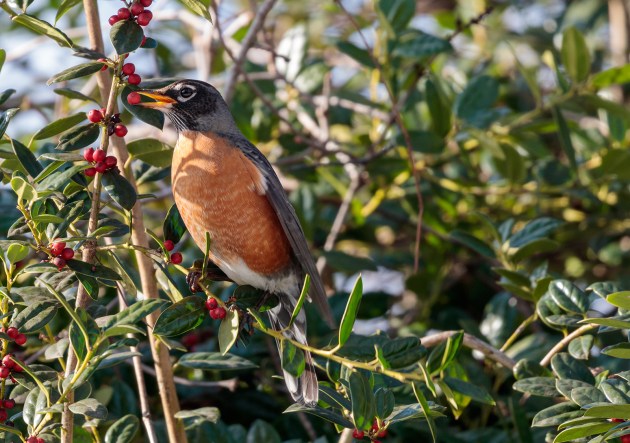
Which is one of the reasons many robins (primarily males) may stay through harsher winters instead of booking it to St. Petersburg: first access to the choicest nesting grounds. Breeding season is when robins also become more visible with mating displays, nest-building and a lot of time on the ground hunting for the tastiest worms. Until then, they’re all about the berries.
You Can Help Robins with Science from Your Own Backyard
Like many species, including other birds, scientists are starting to see some changes in robin behavior that is likely attributable to climate change. One study of American robins migrating to and from Canada’s boreal forest, showed that they’re beginning to journey south on average about 12 days earlier than in past years, or five days earlier per decade since 1994.
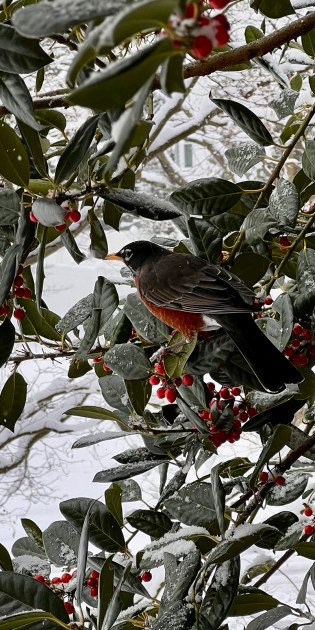
If you want to help scientists studying birds, there are several ways to contribute your observations (not just for robins, but for many of the species you can see outside your windows).
Journey North
You can submit your robin observations directly on the Journey North site (and check out their other migration-related citizen science projects). They also have 2025 maps tracking sightings so you can see where American robins (and other signs of spring) are being observed and follow along (and contribute to) the wanderings of Turdus migratorius.
Cornell Lab of Ornithology
The Cornell Lab has a number of different ways you can contribute to science for birds. Your sightings tracked on eBird (free) contribute to worldwide data for birding, science, and conservation. Want to know what birds are being seen in your neighborhood, eBird has a feature for that. If you’re new to birding, check out their genius birding ID app, Merlin.
You can also contribute to Project FeederWatch (requires subscription) by counting birds at your feeder from November through April. Your observations help scientists monitor changes in the abundance and distribution of birds, including the influence of changes in habitat, disease, and climate.
And mark your calendars for the 2025 Great Backyard Bird Count (February 14-17). Spend time in your favorite places watching birds—then report them to Cornell! It’s easy to participate, “in as little as 15 minutes notice the birds around you. Identify them, count them, and submit your counts to help scientists better understand and protect birds around the world. You can see the results from 2024 here.
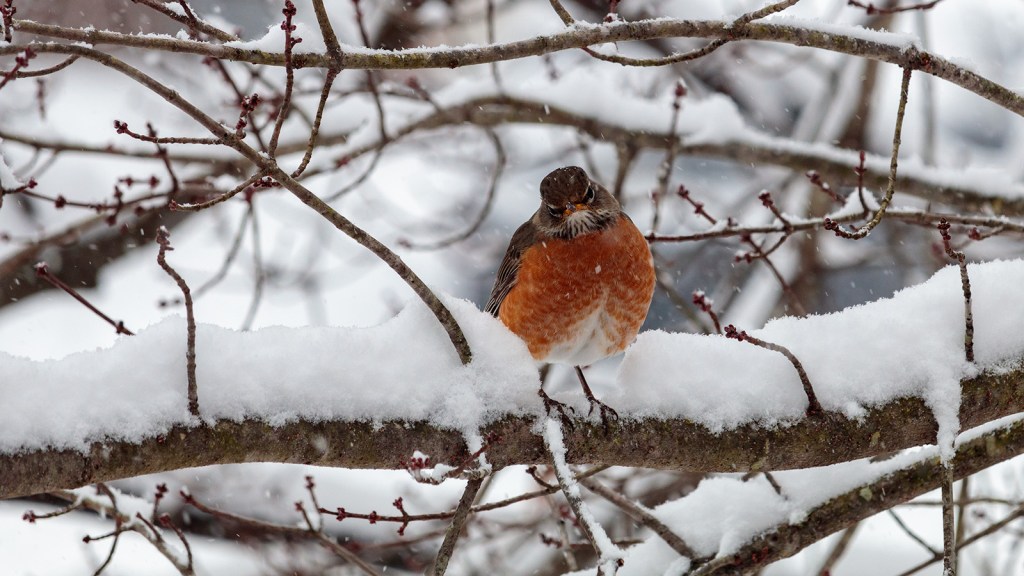



We suddenly have 11 robins in our yard even though its 15* and dropping to 7* at night. They are flying back and forth to a pile of leaves I disturbed when shoveling snow near my garden. They are busy kicking up more leaves!
I looked out my home office this morning and a huge flock of robins eating berries off the tree in the front yard. I’ve never seen this before. We live in Little Rock, Arkansas.
Thanks i was so worried seeing Robins in my yard 2 weeks ago was afraidvthey would freeze to death i was all wasys told they come back in spring so glad to hear they are ok
Okay, so I’ve seen robins for about 2 weeks. It seems so pathetic that they have little to eat. They actually sit on the bird bath for extended periods. Is there anything we can put out for them to eat?
Just a message today 8 th February Day-10. Night-15 I have seen a flock of Robin this morning out the kitchen window, the birds were odd as the colour for winter bird, but it was Robins , I live in Montreal Ahuntsic area
I started hearing Robins just a couple of days ago! Kicker is, it’s 2/7/21, 20F+- daytime , single digits over night AND 15+ INCHES OF SNOW ON THE GROUND! I realize that they’ll feed on wild grapes, sumac and other wild fruits, but WHY SO EARLY? I’m an avid bird watcher and nearing 65 years of age and it seems like this scenario seems to be repeating itself every year with flocks of robins seen on bare lawns that are not providing earthworms, not even, “wormsicles”, because the ground is frozen solid! At this very moment I have a Female Red-winged Blackbird at my feeder, but, I was under the assumption that the males returned first, but I could be wrong on that. At least she can gorge on bird seed, suet and Extra-Crunchy Peanut butter to survive…yum! How much of an affect does climate change have on this behavior of birds, like the Robin, to appear in the heart of Winter? Concerned, Frankie, “The Bird Nerd”!
There are lots of robins here in Sioux Falls, SD!! We feed the birds and hv a warmed source of water for them and hv seen robins drinking!! I love it, but hv never had them stay thru the winter or arrive this early!!!
for the last month I have seen only one robin in the yard across the street. Not another one anywhere?
Just wondering why?
February 6, 2021
Guelph, Ontario, Canada
Yesterday my husband noticed a large flock of fluffed up robins sitting in our oak tree in the front yard – at least two dozen.
Today we noticed a few flirting in and out of the cedar trees in the back yard.
Afternoon temperature minus 8 Celsius with a stiff cold North West breeze.
January 31, 2021. First real snowfall (4+ inches) in about three years for Ladysmith, VA. My wife and I took a walk after the snow, and at the same time that a light sleet rain started to arrive. Anyway on one street, we saw hundreds of robins; two to four dozen per tree, amongst about fifteen trees. (There were smaller numbers among further trees.) Knowing that robins don’t feed from feeders, we felt bad for the robins, since the ground was covered in snow/slush. We assumed that these robins were simply unfortunate to encounter snow during an early migration or something. That said, reading this article has made me feel a lot better regarding the robins’ fate. We love watching the birds at our feeders (and on walks); since we are originally from MI’s U.P. (yes, we are Yoopers), robins have a special place in our hearts.
this is the first time I have ever seen a flock of robins in the dead of winter and during this snowstorm. they are eating the dried up fruit from my ornamental crab apple tree. I hope they will survive this very cold February.
Feb 5, 2021 I saw a flock of robins, around 15 or 20 birds. First time I’ve ever seen flocks of them. Always robins in the summer and many nests, but never saw a flock before. Also heard one singing! Has been warm/cold/warm here in Central NY.
We live in Western North Carolina and around this time of the year flocks of robins come and eat the last berries of the Holly Trees/Shrubs. I can’t really say that I notice them any other time of the year. I would like to have some input whether or not it would be worth the effort to make a nest box, designed for robins, before spring arrives.
Thanks in advance for any input.
For the first time ever in my 71 yrs, I saw a flock of robins fly into our trees, at least 30 of them. I had no idea they would ever show up in our freezing cold , blustery , snowy days. I loved it!! 2-5-2021
It is Feb 4 in southern Wisconsin and we have hundreds of Robins in our trees! They are flying all over the place and a couple have run into our windows. We noticed a few about on Feb 1. Today it was about 34 degrees and I actually heard a Robin sing! We are having a snow storm right now and the temps are dropping between 0 to -13 for the next week during the night. We have never seen Robins so early and definitely not this big of a flock! We live on a lake but it is frozen over. Can’t figure why there are so many so early.